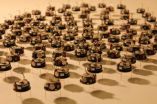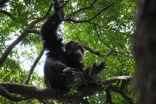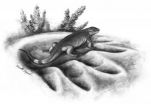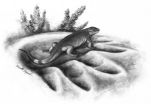(Press-News.org) A way of making hundreds - or even thousands - of tiny robots cluster to carry out tasks without using any memory or processing power has been developed by engineers at the University of Sheffield, UK.
The team, working in the Sheffield Centre for Robotics (SCentRo), in the University's Faculty of Engineering, has programmed extremely simple robots that are able to form a dense cluster without the need for complex computation, in a similar way to how a swarm of bees or a flock of birds is able to carry out tasks collectively.
The work, published today [Thursday 17 April 2014] in the International Journal of Robotics Research, paves the way for robot 'swarms' to be used in, for example, the agricultural industry where precision farming methods could benefit from the use of large numbers of very simple and cheap robots.
A group of 40 robots has been programmed to perform the clustering task and the researchers have shown, using computer simulations, that this could be expanded to include thousands of robots.
Each robot uses just one sensor that tells them whether or not they can 'see' another robot in front of them. Based on whether or not they can see another robot, they will either rotate on the spot, or move around in a circle until they can see one.
In this way they are able to gradually form and maintain a cluster formation. The system's ingenuity lies in its simplicity. The robots have no memory, do not need to perform any calculations and require only very little information about the environment.
Until now robotic swarms have required complex programming, which means it would be extremely difficult to miniaturise the individual robots.
With the programming developed by the Sheffield team, however, it could be possible to develop extremely small – even nanoscale – machines.
The Sheffield system also shows that even if the information perceived by the robots gets partially corrupted, the majority of them will still be able to work together to complete the task.
Roderich Gross, of SCentRo, explains: "What we have shown is that robots do not need to compute to solve problems like that of gathering into a single cluster, and the same could be true for swarming behaviours that we find in nature, such as in bacteria, fish, or mammals."
"This means we are able to 'scale up' these swarms, to use thousands of robots that could then be programmed to perform tasks. In a real world scenario, this could involve monitoring the levels of pollution in the environment; we could also see them being used to perform tasks in areas where it would be hazardous for humans to go. Because they are so simple, we could also imagine these robots being used at the micron-scale, for example in healthcare technologies, where they could travel through the human vascular network to offer diagnosis or treatment in a non-invasive way."
The researchers are now focusing on programming the robots to accomplish simple tasks by interacting with other objects, for example by moving them around or by sorting them into groups.
INFORMATION:
Video of the swarming robots can be seen at https://www.youtube.com/watch?v=LO9JxFLgh94&feature=youtu.be
Simplicity is key to co-operative robots
2014-04-17
ELSE PRESS RELEASES FROM THIS DATE:
At least 1 in 20 adult outpatients misdiagnosed in US every year
2014-04-17
At least one in 20 adults is misdiagnosed in outpatient clinics in the US every year, amounting to 12 million people nationwide, and posing a "substantial patient safety risk," finds research published online in BMJ Quality & Safety.
Half of these errors could be potentially harmful, say the authors, who add that their findings should prompt renewed efforts to monitor and curb the numbers of misdiagnoses.
To date, patient safety improvements have largely focused on hospital stays and issues such as infections, falls, and medication errors, say the authors. But most ...
The Lancet: Changing where a baby is held immediately after birth could lead to improved uptake of procedure that reduces infant iron deficiency
2014-04-17
Changing where a newborn baby is held before its umbilical cord is clamped could lead to improved uptake in hospitals of delayed cord clamping, leading to a decreased risk of iron deficiency in infancy, according to new results published in The Lancet.
Delaying clamping of the umbilical cord until around two minutes after birth allows for blood to pass from the mother's placenta to the baby, and has previously been shown to reduce the risk of iron deficiency in infancy.
However, current recommendations – based on studies conducted 35 years ago – suggest that for effective ...
Chimpanzees prefer firm, stable beds
2014-04-17
Chimpanzees may select a certain type of wood, Ugandan Ironwood, over other options for its firm, stable, and resilient properties to make their bed, according to a study published April 16, 2014 in the open-access journal PLOS ONE by David Samson from the University of Nevada and Kevin Hunt from Indiana University.
Chimpanzees use tree branches to build beds or nests in trees. They select certain tree species to sleep in more frequently than other, but the reason for selecting a particular tree is unclear. To determine whether the physical properties of trees influenced ...
In funk music, rhythmic complexity influences dancing desire
2014-04-17
Rhythmic drum patterns with a balance of rhythmic predictability and complexity may influence our desire to dance and enjoy the music, according to a study published April 16, 2014 in the open-access journal PLOS ONE by Maria Witek from University of Oxford and colleagues from Aarhus University, Denmark and Oxford University.
Many people find themselves unable to resist moving their bodies to the thumping beat of hip-hop, electronic, or funk music, but may feel less desire to dance when listening to a highly syncopated type of music, like free jazz. Researchers interested ...
New species discovery sheds light on herbivore evolution
2014-04-17
A new fossil may provide evidence that large caseid herbivores, the largest known terrestrial vertebrates of their time, evolved from small non-herbivorous members of that group, according to a study published April 16, 2014 in the open-access journal PLOS ONE by Robert Reisz from University of Toronto and Jörg Fröbisch of the Museum für Naturkunde.
The origin and early evolution of vertebrates living on land led to major changes in the structure of terrestrial ecosystems. The first appearance of herbivores played a pivotal role in this transformation, and a newly discovered ...
Research may help doctors predict who gets long-term complications from Lyme disease
2014-04-17
A team of scientists led by Johns Hopkins and Stanford University researchers has laid the groundwork for understanding how variations in immune responses to Lyme disease can contribute to the many different outcomes of this bacterial infection seen in individual patients. A report on the work appears online April 16 in PLOS One.
"Physicians have recognized for many years that Lyme disease is not a uniform disease process and can vary in outcomes," says Mark Soloski, Ph.D., a professor of medicine at the Johns Hopkins University School of Medicine and senior author of ...
Off-season doesn't allow brain to recover from football hits, study says
2014-04-17
Six months off may not be long enough for the brains of football players to completely heal after a single season, putting them at even greater risk of head injury the next season.
"I don't want to be an alarmist, but this is something to be concerned about," said Jeffrey J. Bazarian, M.D., associate professor of Emergency Medicine at the University of Rochester School of Medicine and Dentistry and lead author of the study, published in PLOS ONE.
"At this point we don't know the implications, but there is a valid concern that six months of no-contact rest may not be enough ...
Earliest ancestor of land herbivores discovered
2014-04-17
New research from the University of Toronto Mississauga demonstrates how carnivores transitioned into herbivores for the first time on land.
"The evolution of herbivory was revolutionary to life on land because it meant terrestrial vertebrates could directly access the vast resources provided by terrestrial plants," says paleontologist Robert Reisz, a professor in the Department of Biology. "These herbivores in turn became a major food resource for large land predators."
Previously unknown, the 300-million-year old fossilized juvenile skeleton of Eocasea martini is ...
Banning chocolate milk backfires
2014-04-17
ITHACA, N.Y. – To some, banning chocolate milk from elementary schools seemed like a good idea, but new Cornell University research shows that removing chocolate milk from school menus has negative consequences.
"When schools ban chocolate milk, we found it usually backfires. On average, milk sales drop by 10 percent, 29 percent of white milk gets thrown out, and participation in the school lunch program may also decrease," reports Andrew Hanks, lead author and research associate Cornell's Dyson School of Applied Economics and Management. "This is probably not what parents ...
Researchers see hospitalization records as additional tool
2014-04-17
MEDFORD/SOMERVILLE, Mass. – Comparing hospitalization records with data reported to local boards of health presents a more accurate way to monitor how well communities track disease outbreaks, according to a paper published April 16 in the journal PLOS ONE by a research team led by Elena Naumova, Ph.D., professor of civil and environmental engineering and associate dean at Tufts University School of Engineering.
In a paper titled "Hospitalization Records as a Tool for Evaluating Performance of Food and Water-Borne Disease Surveillance Systems: A Massachusetts Case Study," ...





